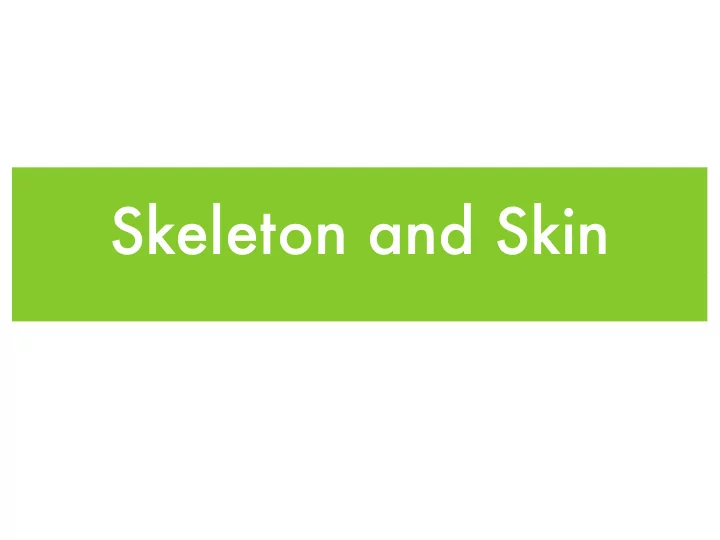

Skeleton and Skin
What is skinning? • Skinning is the process of creating association between the character’s skeleton (articulated rigid bodies) and its skin (meshes).
Deformation Algorithms • Should handle the general problem of skeleton influenced deformation rather than treating each area of anatomy as a special case � • Should allow direct manipulation of the desired deformations � • Common practice: shape interpolation, skeleton subspace deformation (SSD) � • Advanced methods: pose space deformation (PSD), data-driven method, dual quaternion, etc
• Shape interpolation � • Skeletal subspace deformation (skinning) � • Pose space deformation � • Data-driven deformation � • Dual quaternion
Shape Interpolation • Surface control vertices are a linear combination of the corresponding vertices on key shapes: � X S k : w k S k � k =0 • Shapes are independent of the skeletal motion � • Interpolated shapes might be distorted
SSD (Skinning) • A vertex on the deforming surface of an articulated object lies in the subspace defined by the rigid transformations of that point X p = ¯ w i C i ( p ) p
Skin Collapsing • The vertex position in the mesh deformed by linear blend skinning (SSD) is computed as: n ! n X X ¯ p = w i C i ( p ) p = w i C i ( p ) p i =1 i =1
Dual Quaternion Skinning • Dual quaternion skinning solves the problem of linear skinning methods with minimal additional cost. � • No skin collapsing effects exhibited by linear skinning will manifest themselves. � • Maya uses dual quaternion skinning now.
Maya Demo • Rigid bind � • Linear skinning with diff max bone numbers � • Dual quaternion � • Interactive smooth bind � • Paint weights
Dual Quaternion • Define dual numbers � • Define dual quaternion � • Define unit dual quaternion � • Rotation using dual quaternion � • Translation using dual quaternion � • Rigid transformation
Blend Dual Quaternions DLB always returns a rigid transformation, because DLB computes a unit dual quaternion
Pose Space Deformation • The artist sculpts a deformation for a given pose and assigns a falloff function for interpolation � • Define deformation function at sculpted poses � rigid movement with skeleton deviation for this pose p + δ ( q ) � • Interpolate deformation for each vertex based on the current skeleton pose � • Adjust interpolated deformation if needed
PSD vs SSD
Data-driven Deformation • Use a mocap system and 350 markers to capture body deformation � • The skin motion can be computed by segmenting the markers into rigid motion and a residual deformation
Range Scans • Example data consists of range scans of a human body in a variety of poses � • Construct a mutually consistent parameterization of all the scans using a posable subdivision surface template � • The detail deformations are represented as displacements from this surface
Recommend
More recommend